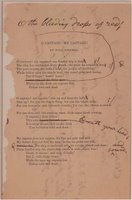Paul Adrian Maurice Dirac
In my last two years of Bachelors' programme in the department, I had to read many science papers, some for a literature survey, some for more detailed study and some even for continuing the research further. Many papers written by many authors; some physicists, some mathematicians. Some were easy to read and understand even for a “lay-man”. Some were really meant for people pursuing the subject fiercely. But there were papers by one man that were different. Its like among many dates in your life, you remember one or two special ones, the day you proposed to your girl or some such day! It had a really different aspect to it. Its like you hide the author's name and ask me to read the paper and I will tell you “its his isn't it?”. I was asked to do a term paper on magnetic monopoles and I came across his paper while searching for the literature. I fell in love with his style, instantly. Well, not instantly, really, because I had to read it thrice to digest the maths; more so because of his style. With due respect to all physicists, he never repeats a idea, never tries to put a single idea in as many words as possible. He is a master at making concise statements. A genius in being precise. Thats how I tried to know more about him. Thats how he became one of my three favourite physicists. I was reading “The Theory of Magnetic Poles” by Dirac, Phys. Rev. 74, 817-830, 1948.
Paul Adrian Maurice Dirac
We (physics students) use Dirac's products so many times: Dirac's delta distribution(it would be bad to call it a function after the recent campaign by a maths prof.), Fermi-Dirac statistics, Dirac's Bra-Ket notation (that was one beautiful thing), Dirac's wave equation, Dirac's quantization equation and many more. So its only just to know some more about him.
Dirac is one of the giants on whose shoulders my areas of interest stand (firmly so). He is the founder of quantum electrodynamics and worked extensively on quantum mechanics; the work is published in his book “Principles of Quantum Mechanics” (1930); I am afraid it is out of print, (atleast so in India) but I know someone who has a copy and I am sure he is proud of his possession. Dirac introduces the Bra-Ket notation and the Delta distribution in this book. Dirac, being one of the founders of Quantum Mechanics, is one of the few physicists who truly understood the whole business of quantum physics. After all, he formulated a complete mathematical description of quantum mechanics. Dirac noticed an analogy between the old Poisson brackets of classical mechanics and the then recently proposed quantization rules in Werner Heisenberg's Matrix formulation of quantum mechanics, which led to formulation of quantization rules in a novel and more illuminating manner. For this work, published in 1926, he received a Ph.D. from Cambridge. Dirac predicted the existence of positron, the electron's anti-particle, which he interpreted in terms of what is known as Dirac sea (of particles). The famous and important Dirac Equation, not mentioning its other properties, integrates two (opposite) frameworks: the quantum theory and the relativity theory. Quantum spin turns out to be obvious and necessary from this equation.
I would like to digress a little to explain in some detail the essentials of the theory of magnetic poles by Dirac.
“If one supposes that a particle with a single magnetic pole can exist and that it interacts with charged particles, the laws of quantum mechanics lead to the requirement that the electric charges shall be quantized—all charges must be integral multiples of a unit charge e connected with the pole strength g by the formula eg=1 / 2ℏc. Since electric charges are known to be quantized and no reason for this has yet been proposed apart from the existence of magnetic poles, we have here a reason for taking magnetic poles seriously. The fact that they have not yet been observed may be ascribed to the large value of the quantum of pole.”
That is an extract from the abstract of his paper. In other words, Dirac showed that existence of a magnetic monopole is sufficient (and necessary?) to explain the observed quantization of charge. Some of you might be wondering whats so difficult in finding a magnetic pole. The problem is all magentic poles you and I have seen so far exist as dipole. A bar magnet has two poles (named north and south). No matter how many times you cut the magnet in half, you always end up with a dipole. Infact, no “scientific” evidence of monopole exists till date. I insist on scientific, because there have been rumours of evidence. However, the very nature of the experiment is non-scientific. The experiment consists of setting up a superconducting ring at some place where you think the monopole might pass through. Let a small current go round and round in the ring and wait for the monopole to shower its grace on you. If the monopole indeed passed through the ring, according to Faraday's laws, you would notice a increase in amplitude of current. So you see, the experiment relies on chance and therefore is non-scientific (Q.E.D!). Added to this is catch in Dirac's statement. Existence of even one monopole is enough. And that one monopole can be existing just anywhere in this vast vast universe.
Coming back to Dirac, I would like to iterate that he is precise. You might want to argue that one should try to explain any concept in as many words as possible. In reality it does not work with science concepts. I have tried it myself. The more you try to explain, the farther you move away from the truth. Dirac's brevity, I think, should be attributed to his BA in Applied Mathematics. Yes, Dirac is as much a mathematician as he is a physicist. We all know, maths is the language of physics, and he writes poetry with maths. Unfortunately (and this is where I don't agree with him), his stand on poetry itself is best expressed in his own words:
“In science one tries to tell people, in such a way as to be understood by everyone, something that no one ever knew before. But in poetry, it's the exact opposite.”
Nevertheless, Dirac believed in “beauty”. Quoting his words, “This result is too beautiful to be false; it is more important to have beauty in one's equations than to have them fit experiment.” and “If one is working from the point of view of getting beauty into one's equation, ... one is on a sure line of progress.”
Here is where I would like to make another digression. Dirac had one regret. He was deeply dissatisfied with the renormalization approach to dealing with infinites in Quantum Field Theory. In his own words (again): “I am very disturbed by the situation because the so-called good quantum theory does involve neglecting infinities in an arbitrary way. This is not sensible. Sensible Mathematics involves neglecting a quantity when it's small; not because it's infinitely great and we do not want it”. It is expected of a man who saw beauty in all the work. But this dissatisfaction is something that he shares with Albert Einstein (and may be other physicists, too). Einstein after his fame in coming up with theories of relativity, spent later years of his life trying to formulate a unified theory of universe; one theory to explain everything. So did Dirac spend his later years trying to do away with the renormalization approach. In both the cases, the physics community claims, they “digressed from the mainstream”. I think its a polite way of saying they have gone crazy. But I would not agree with that view. History is full of reknown artists and scientists whose work from their later years of life was not understood and appreciated. I would like to think, these people moved on to a higher plane, leaving us to our ignorance.
Coming back again, Dirac brought to his personal life, the logical directness he used in his scientific work. A testimonial to this is a story of his typical attitude to a questioner at the end of a lecture. The man indicated that he did not follow a particular point of Dirac's argument. A silence followed and at last the chairman asked if Professor Dirac would deal with the question. The inevitable reply that followed was, “It was a statement, not a question”. Talking about his attitude, Dirac was noted for his modesty. He called the equation for the time-evolution of a quantum-mechanical operator, which Dirac was in fact the first to write down, the "Heisenberg equation of motion". Most physicists speak of Fermi-Dirac statistics for half integer spin particles and Bose-Einstein statistics for integer spin particles. While lecturing later in life, Dirac always insisted on calling the former "Fermi statistics". He referred to the latter as "Einstein statistics" for reasons, he explained, of "symmetry".
Paul Dirac (August 8, 1902 – October 20, 1984) was a British theoretical physicist born in Bristol. He held the Lucasian Professor of Mathematics at the University of Cambridge. He shared the Nobel Proze in Physics, 1933, with Erwin Schrodinger for “the discovery of new productive forms of atomic theory”. He was elected a Fellow of the Royal Society in 1930, being awarded the Society's Royal Medal and the Copley Medal. He was elected a member of the Pontifical Academy of Sciences in 1961.
I would like to end this article by mentioning again his unique style: There is a standard folklore of Dirac stories, revolving around Dirac saying exactly what he meant and no more. When Niels Bohr complained that he did not know how to finish a sentence in a scientific article he was writing, Dirac replied, "I was taught at school never to start a sentence without knowing the end of it”.
So thats Dirac to me, my favourite physicist.
In this context I would like to mention one commonly occuring flaw when students write mathematical equations, something that I often notice and hate. Mathematics is a language and without relevant grammar and punctuation it is meaningless. Which is why it is important to always mention the domain, when you write a function!
Jade.






